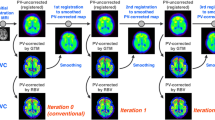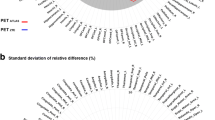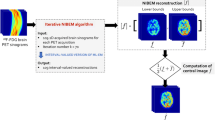Abstract
Objective
Head motion during 30-min (six 5-min frames) brain PET scans starting 30 min post-injection of FDG was evaluated together with the effect of post hoc motion correction between frames in J-ADNI multicenter study carried out in 24 PET centers on a total of 172 subjects consisting of 81 normal subjects, 55 mild cognitive impairment (MCI) and 36 mild Alzheimer’s disease (AD) patients.
Methods
Based on the magnitude of the between-frame co-registration parameters, the scans were classified into six levels (A–F) of motion degree. The effect of motion and its correction was evaluated using between-frame variation of the regional FDG uptake values on ROIs placed over cerebral cortical areas.
Result
Although AD patients tended to present larger motion (motion level E or F in 22 % of the subjects) than MCI (3 %) and normal (4 %) subjects, unignorable motion was observed in a small number of subjects in the latter groups as well. The between-frame coefficient of variation (SD/mean) was 0.5 % in the frontal, 0.6 % in the parietal and 1.8 % in the posterior cingulate ROI for the scans of motion level 1. The respective values were 1.5, 1.4, and 3.6 % for the scans of motion level F, but reduced by the motion correction to 0.5, 0.4 and 0.8 %, respectively. The motion correction changed the ROI value for the posterior cingulate cortex by 11.6 % in the case of severest motion.
Conclusion
Substantial head motion occurs in a fraction of subjects in a multicenter setup which includes PET centers lacking sufficient experience in imaging demented patients. A simple frame-by-frame co-registration technique that can be applied to any PET camera model is effective in correcting for motion and improving quantitative capability.






Similar content being viewed by others
References
Thomas B, Lutz T, Ingo N, Uwe P. On the use of positioning aids to reduce misregistration in the head and neck in whole-body PET/CT studies. J Nucl Med. 2005;46(4):596–602.
Andrew JM, Kris T, Mitul AM, Federico T, Sanida M, Paul MG. Correction of head movement on PET studies: comparison of methods. J Nucl Med. 2006;47(12):1936–44.
Jurgen EMM, Mark L, Floris HPV, Adriaan AL, Ronald B. Off-line motion correction methods for multi-frame PET data. Eur J Nucl Med Mol Imaging. 2009;36:2002–13.
Minoshima S, Koeppe RA, Fessler JA, Mintun MA, Berger KL, Taylor SF, et al. Integrated and automated data analysis method for neuronal activation studies using [O-15] water PET. In: Proceedings of PET 93 Akita: quantification of brain function, tracer kinetics and image analysis in brain PET. Elsevier: Amsterdam; 1993. p. 409–15.
Maes F, Collignon A, Vandermeulen D, Marchal G, Sutens P. Multimodality image registration by maximization of mutual information. IEEE Trans Med Imaging. 1997;16(2):187–98.
Joseph AM, Paul JL, Kraft RobertA, Jonathan HB. An automated method for neuroanatomic and cytoarchitectonic atlas-based interrogation of fMRI data sets. Neuroimage. 2003;19(3):1233–9.
Joseph AM, Paul JL, Kraft RobertA, Jonathan HB. Precentral gyrus discrepancy in electronic versions of the Talairach atlas. Neuroimage. 2004;21(1):450–5.
Tzourio-Mazoyer N, Landeau B, Papathanassiou D, Crivello F, Etard O, Delcroix N, et al. Automated anatomical labelling of activations in SPM using a macroscopic anatomical parcellation of the MNI MRI single subject brain. NeuroImage. 2002;15:273–89.
Minoshima S, Frey KA, Koeppe RA, Foster NL, Kuhl DE. A diagnostic approach in Alzheimer’s disease using three-dimensional stereotactic surface projections of [18F]FDG. J Nucl Med. 1995;36:1238–48.
R Development Core Team. R: a language and environment for statistical computing. Vienna: R Foundation for Statistical Computing; 2006.
Holm S. A simple sequentially rejective multiple test procedure. Scand J Stat. 1979;6:65–70.
Kendall MG. A new measure of rank correlation. Biometrika. 1938;30(1/2):81–93.
Acknowledgments
This study is a part of the “Translational Research Promotion Project/Research project for the development of a systematic method for the assessment of Alzheimer’s disease,” sponsored by the New Energy and Industrial Technology Development Organization (NEDO) of Japan. J-ADNI is also supported by a Grant-in-Aid for Comprehensive Research on Dementia from the Japanese Ministry of Health, Labour and Welfare, as well as by the grants from J-ADNI Pharmaceutical Industry Scientific Advisory Board (ISAB) companies. The authors would also like to thank the J-ADNI Imaging ISAB and other organizations for their support of this work.
Author information
Authors and Affiliations
Corresponding author
Rights and permissions
About this article
Cite this article
Ikari, Y., Nishio, T., Makishi, Y. et al. Head motion evaluation and correction for PET scans with 18F-FDG in the Japanese Alzheimer’s disease neuroimaging initiative (J-ADNI) multi-center study. Ann Nucl Med 26, 535–544 (2012). https://doi.org/10.1007/s12149-012-0605-4
Received:
Accepted:
Published:
Issue Date:
DOI: https://doi.org/10.1007/s12149-012-0605-4




